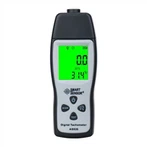The meaning of resolution and accuracy of digital display instrument
Regarding the meaning of the resolution and accuracy of the digital display instrument, the power value corresponding to the last word of the digital display instrument on the minimum range is called the resolution, 1.6%±6 words refers to the accuracy of the instrument, pay attention to 1.6% It is separated from the ±6 characters, and two methods are used to express the accuracy of the instrument.
The meaning of digital display instrument resolution and accuracy
Look at the selection of the FLUKE clamp meter, one of the technical specifications: digital display frequency: 6000 word resolution. I don't know what the 6000 words mean? There is also a writing accuracy of 1.6% ± 6 characters {40A} and I don't know what it means."
The power value corresponding to the last word of the digital display instrument on the minimum range is called the resolution. As often said, the highest resolution of a digital multimeter is 10μV, etc.; it reflects the sensitivity of the instrument. When the resolution is expressed as a percentage, that is, the ratio of the smallest number to the largest number that can be displayed, it is called the resolution.
For example, the word 6000 refers to the sensitivity of the display resolution of the watch, that is, the ability to identify small amounts of electricity. In layman's terms, it is assumed that the input signal is 0-1V, and the meter displays the digital quantity after A/D conversion, that is to say, 0~1V is divided into 6000 parts (words), 0V corresponds to 0, and 1V corresponds to 6000. So the higher the resolution, the more accurate the result when measuring small signal changes. Taking the 317/319 clamp meter as an example, it displays 4 digital tubes. Since the largest digit can display 5 and 6, and the smallest digit that can be displayed is 1, the meter is a three-and-three-quarter meter, then The maximum display value of the table is 5999 (the nominal value is 6000), so the resolution of the table is 1/5999, which is approximately equal to 0.016%.
1.6% ± 6 characters refers to the accuracy of the instrument, note that 1.6% and ± 6 characters are separated, that is to say, it uses two methods to express the accuracy of the instrument, at 40A: one is 1.6%, The other is ±6 characters.
There are three ways to express the accuracy of the digital display instrument:
1. △=±α%FS
2. △=±(α%FS +b)
3. △=±N
In the formula: △—maximum allowable error;
α—accuracy level;
FS—meter range, that is, the difference between the upper and lower limits of the measurement range;
b—meter resolution;
N—the maximum allowable error directly expressed by physical quantity.
The meter accuracy class of the first expression method is represented by α.
The second method of expression, when the quantization error of the instrument can be omitted compared with the comprehensive error caused by other factors (generally α%FS≥10b), it can be simplified as α.
The meters of the third expression method are not expressed in accuracy classes.
but:






